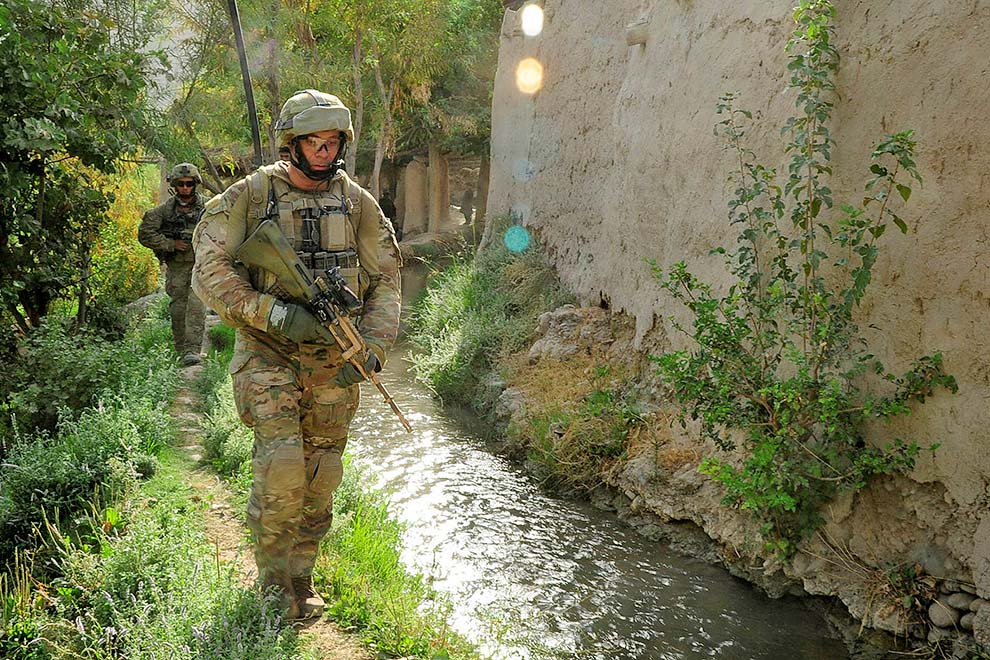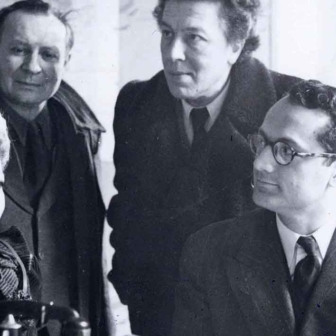On Ops: Lessons and Challenges for the Australian Army since East Timor
By Tom Frame and Albert Palazzo | UNSW Press | $39.99
Opinion polls show that the Australian Defence Force is our most trusted national institution. As part of that force, the army employs almost 30,000 Australians full-time and another 14,000 part-time, and gobbles up a fair slab of the $32 billion we spend every year on defence. Its deeds are the central focus of our de facto national day, Anzac Day. Yet it’s safe to assume most of us know little about it.
Our citizens in army uniform have been “on ops” – serving in military operations – constantly for close to seventeen years. During at least one of those years, they were doing their soldierly business in five countries at once, stretching from Afghanistan, where they fought and died in what has become our longest war, to Tonga.
You might think spending your taxes on the army is a waste, and that its core function – applying lethal violence on government orders – is morally objectionable. If so, consider this. Seventeen years ago, an irresistible wave of popular indignation – which you might have shared – forced the Australian government to send troops to East Timor to end a campaign of terror unleashed by the Indonesian military after the Timorese voted for independence. Here was the army defending the human rights of a neighbour. And this is where an unbroken series of military operations began.
Whatever you think about the army, it has taken the tentative and uncharacteristic step of publicly and critically evaluating itself, as it tries to learn lessons from its operations between 1999 and 2014. This book, based on papers presented at a conference the army co-hosted last year, is part of an unprecedented review by an institution that shares some common Australian traits – a resentment of criticism, a reluctance to engage in honest self-evaluation, and a preference for “doing” rather than thinking. Its editors describe it as the start of what the army hopes will be a conversation with the Australian people.
The sixteen chapters in On Ops are written by current and former military officers, departmental officials, academics, a journalist, and former prime minister John Howard. Ordinary citizens wanting to know what the army’s been up to will at times have to fight through thickets of jargon and acronyms. In some sections, it’s clear that copyeditors and proofreaders went missing in action.
But if they battle on, readers will learn a lot. Citizens who wanted the government to send troops to East Timor in 1999, for instance, will discover that Canberra feared we could suffer up to 500 casualties in an operation that came close to disaster.
The army that was despatched to East Timor had emerged from the “long peace” that followed the Vietnam war, a time when soldiers played war games against fictional enemies – the Kamarians or the Musarians – who conveniently could be towed around our coastline to wherever suited exercise planners. It was a time, as former army chief Peter Leahy puts it, when the army just got smaller. This, he says, made it all the more remarkable that it was able to lead an international force to success in East Timor.
Its task in 1999 was as easy as they come – close to Australia, supported by the United Nations and a coalition of countries, and (despite some skirmishes) involving little organised armed resistance.
Yet, from day one, the intervention exposed glaring deficiencies in army logistics, command-and-control processes, and decision-making. The shuttle of Hercules transports flying troops from Darwin to Dili was confused, disjointed and uncoordinated. At the end of day one, with Dili still burning, militias still rampaging, the entire population displaced, and thousands of resentful Indonesian troops still in the territory, Australia had only a few hundred infantry and two armoured personnel carriers on the ground. They had only the water, food and ammunition they carried.
In ensuing days, some troops weren’t issued helmets and ballistic vests because they “weren’t entitled” to them. Adequate ammunition didn’t arrive until six days after the initial landing. Fuel deliveries were ad hoc. Troops picked through abandoned Indonesian barracks for medical supplies. Intelligence wasn’t shared and commanders were given only a trickle of information. “The list of deficiencies could go on – and on,” writes Craig Stockings, former army officer and now official historian. He says the fact that the entire operation didn’t collapse is due to the hard work, flexibility and professionalism of individuals.
Stockings delivers a clear warning about the cultural impediments the army must overcome if it is to learn the lessons of Timor. His focus on logistics is shared by others who challenge the way the army sees itself – as a warrior caste that gives precedence to “combat” soldiers above those who support and sustain them.
It’s a theme taken up by Allison Sonneveld, a researcher at army headquarters. On the East Timor operation, she reveals that, six weeks after the first landing, some soldiers were still sleeping on the ground without tents and were washing their clothes in tins. She, too, questions whether the army’s warrior culture has marginalised the role of areas like logistics. So does David Beaumont, a serving officer, who says the understandable allocation of resources to combat capabilities during the lean times of the “long peace” meant risks were accepted in logistics that “brought the army to the precipice of operational failure” in East Timor.
The evidence in On Ops is that the army has not fully learned the lessons of East Timor or its subsequent experience in Iraq and Afghanistan, where it relied on the support of generous coalition partners to ensure troops were fed, fuelled, supplied and properly treated when wounded. This support is unlikely to be available if the army is again required to operate in our own region.
If logistics are often overlooked in public consideration of the army, so too are medical services. Army medical teams sent to East Timor handled only a handful of combat casualties. As things turned out, the most common surgeries they performed were caesarean operations on Timorese civilians.
Things changed in Afghanistan, where improvised explosive devices took a toll. In sparse, clinical language, army surgeon Anthony Chambers reveals what these crude weapons did to our soldiers. They lost arms and legs, and suffered blast, fragmentation and penetration wounds. Body armour offered some protection. But since it can’t cover the entire body, wounded soldiers commonly suffered devastating injuries to the limbs, pelvis, genitalia, neck and face.
The army didn’t release this sort of detail at the time. Instead, its media releases dealing with casualties accentuated the positive: wounds were not life-threatening, the soldier would recover and was receiving excellent treatment. The treatment was, in fact, outstanding. Rapid helicopter evacuation meant wounded soldiers had a 98 per cent survival rate if they were alive when they reached first-class hospitals run by our Dutch and American allies.
It’s clear from Chambers that military medical services have been stretched by constant deployments. The ability to recruit and retain doctors and surgeons is under strain, putting pressure on the army’s small pool of specialists. One wonders, then, how they would have coped if the army had suffered 500 casualties in East Timor.
What emerges from On Ops is evidence that the army is better equipped and trained than ever before, with its ranks full of capable soldiers who’ve honed their skills. At the same time, uncomfortable questions remain. These are distilled by John Blaxland, historian and former army officer, who points out that the army’s recent focus on the Middle East means its knowledge of the Asia-Pacific region has been dangerously neglected, to the point that it now knows less about the region than it did back in 1999.
The army’s reliance on special forces in the Middle East “wars of choice” might teach it false or incomplete lessons that won’t apply if it faces a “war of necessity” closer to home. It has emerged from years of operations as a “respected boutique army,” Blaxland says. “What it does, it can do very well.” But he wonders about its capacity to fight a more intensive conflict closer to home.
Blaxland believes that Australian Defence Force commanders need to think through “the strategic implications” for politicians who commit the ADF to overseas operations. He doesn’t spell out what he means here, beyond saying that the ADF needs to advise governments on long-term implications of the use of force, particularly in our immediate region. Implicit here is the suggestion that, when asked to perform a mission, our generals have tended to get on with the job, rather than think it through. They remain doers, rather than thinkers.
The operations since 1999 have come at a hidden human cost. Academic and former navy officer Tom Frame poses unsettling questions about “moral injuries” that soldiers suffer. These are distinct from post-traumatic stress disorder. Rather, moral injuries are inflicted when soldiers’ experiences are an affront to their moral principles or the social conventions they’ve grown up with, resulting in feelings of loathing and despair. Frame appeals for more research in this area, saying that “helping the morally injured to narrate their own life appears to be the foremost emerging challenge.” He says recent operations have left service personnel “deeply wounded when they believe they have been manipulated or mistreated by those they trusted.”
Frame’s contribution indirectly exposes a significant gap in the topics covered by On Ops. There’s no mention of civilian casualty incidents in Afghanistan, yet these clearly raise questions not only about the technical conduct of army operations, but also about the ethical and legal issues involved. There’s no mention, either, of the army’s role in operations to repel or detain asylum seekers. Yet clearly these operations, leading to the indefinite detention of genuine refugees in isolated Pacific Island camps, have the potential to cause moral injury to everyone involved.
If refugees are people who can just be moved around at will, what of those ordered to do the moving around? Frame appeals for a greater commitment to the wellbeing of those in uniform. He says their leaders face a principal humanitarian question regarding those under their command: “Do those being led have intrinsic value as people, a value that is honoured, or are they simply another asset to move around the battlespace? If the latter, we might conclude that soldiers are effectively being stripped of their humanity, not by adversaries but by Australians. And if this is so, you do wonder what all this fighting is for.” •




